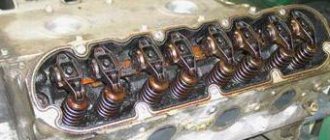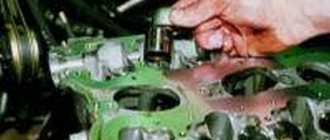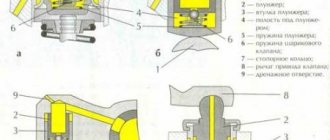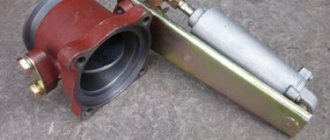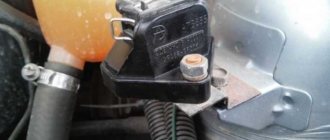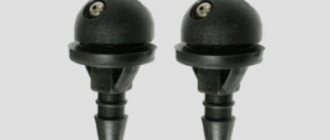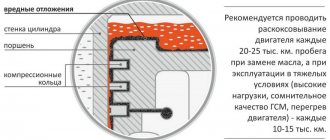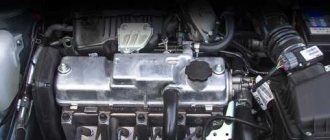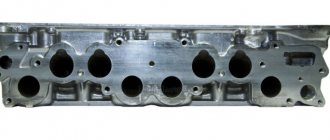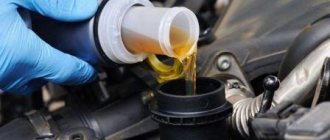"Pros" and "cons" of using hydraulic compensators in engines
The introduction of the hydraulic valve made it possible to avoid adjusting the clearances of the valve mechanism and make its operation “softer”; reduce shock loads, that is, reduce wear on timing parts and eliminate increased engine noise; more accurately observe the duration of the valve timing, which has a positive effect on the safety of the engine, its power and fuel consumption.
With all their advantages, hydraulic compensators also have disadvantages, and engines equipped with them have some operating features. One of the design flaws of simple hydraulic compensators manifests itself in poor performance of a cold engine in the first seconds of start-up, when there is no oil pressure in the lubrication system or it is minimal. Read about the features of operation, repair and maintenance of engines with main thrusters in the following issues of AC.
| There are no consequences |
Intake and exhaust valves heat up to different temperatures, so the thermal clearances required for them are different: for intake valves - 0.15: 0.25 mm, and for exhaust valves - 0.20: 0.35 mm and even more. If these values are not met, the consequences can be very different:
|
| Historical reference |
| The first patents for hydraulic valve lash compensators were registered in the USA in 1920. Since 1960, 90% of all American passenger cars have been mass-produced with hydraulic lifters. Production of HA in Germany began in 1971. Since 1978, most other leading automobile companies have been using this technology as standard. |
Advantages and disadvantages
Hydraulic compensators allow you to avoid many technical problems during engine operation. There is no need to adjust the thermal gap, for example, using washers. Hydraulic pushers also reduce noise levels and shock loads. Smooth and correct operation reduces wear on timing parts.
Among the advantages there are also disadvantages. Engines that use hydraulic compensators have their own operating characteristics. The most obvious of them is uneven operation of a cold engine at startup. Characteristic knocking sounds appear, which disappear when the temperature and pressure are reached. This occurs because the oil pressure is insufficient at startup. It does not enter the compensators, so there is a knock.
Another disadvantage is the cost of parts and maintenance. If replacement is required, it should be entrusted to a specialist. Also, hydraulic compensators are demanding on the quality of the oil and the operation of the entire lubrication system. If you fill in low-quality oil, this can directly affect their performance.
Design and principle of operation of hydraulic compensators
The device of a standard hydraulic compensator is represented by a housing with a movable plunger pair inside, which includes a spring-loaded plunger with a ball valve and a bushing. The housing can be a part of the cylinder head, a cylindrical pusher, or elements of valve drive levers.
The operation of the hydraulic compensator largely depends on the plunger pair. Thanks to a gap of 5 - 8 microns between the plunger and the bushing, on one side the connection is completely sealed, and on the other side the parts move freely relative to each other.
A check ball valve closes the hole in the bottom of the plunger, and a spring of the required stiffness is installed between the plunger and the bushing.
The operating principle of hydraulic valve compensators is discussed in more detail below:
- The thermal gap remains between the camshaft and the housing at the moment when the camshaft cam is positioned with its back side towards the pusher.
- Through the oil channel, oil enters the plunger from the lubrication system, and at the same time a spring acts on the plunger and lifts it, compensating for the gap. Oil also enters the cavity under the plunger.
- As the shaft turns, pressure is exerted on the follower from the cam side, causing it to move downward.
- The check ball valve closes, and the plunger pair takes on the role of a rigid element, transmitting force to the valve.
- A little oil is squeezed out from under the plunger because there is a gap between it and the bushing, but since the oil comes from the lubrication system, the leakage is compensated.
- The length of the hydraulic compensator changes slightly because the parts heat up when the engine is running, but the gap is automatically compensated by changing the volume of the oil portion.
Can hydraulic compensators knock due to oil?
Why are hydraulic compensators knocking and what should I do?
| The hydraulic compensator, also known as a hydraulic pusher, is designed to automatically adjust the thermal clearances of engine valves. While operating the car, you can hear the engine knocking, they say it is the hydraulic compensators knocking. Do you know the causes of this malfunction and how to deal with it? |
How to determine which hydraulic compensator is knocking?
- To check the hydraulic compensator, you need to press it with a soft metal drift or a screwdriver (with the camshaft cam facing the pusher with the back of its head). In normal condition, the hydraulic pusher should be pressed with considerable force. If the force is small, the hydraulic pusher must be replaced.
- Install the camshaft cams one at a time with the protrusions facing up and check for clearance between the pushers and the cams. When pressing (for example, with a wooden wedge) the hydraulic pusher being tested, compare the speed of its movement with the others. If there is a gap or an increased speed of movement, disassemble the hydraulic compensator and clean its parts from dirt or replace the hydraulic compensator.
Why are hydraulic compensators knocking?
| Cause of malfunction | Remedy |
| Oil leakage from part of the hydraulic compensators during long-term parking | Noise that disappears a few seconds after starting the engine is not a sign of a malfunction, since some of the hydraulic compensators that were under the load of the valve springs of the open valves (the oil supply channels remained open) leaked oil, the deficiency of which is replenished at the beginning of engine operation |
| Damage or wear of the check valve ball Contamination of the hydraulic compensator mechanism with wear products due to untimely oil changes or poor quality | Replace the hydraulic compensator. Clean the mechanism parts from dirt. Use the oil recommended in the owner's manual |
| Oil flows through the gaps between the plunger and the hydraulic compensator sleeve, which have increased due to wear | Replace the worn hydraulic compensator assembly |
| Foaming when there is excess oil (above the top mark on the dipstick) in the oil sump due to its agitation by the crankshaft. The entry of an air-foam oil mixture into the hydraulic compensators disrupts their operation. Air is sucked into the oil pump when the oil level in the oil sump is excessively low. Damage to the oil receiver due to deformation of the oil sump when hitting a road obstacle. | Bring the oil level in the oil sump to normal Bring the oil level in the oil sump to normal Repair or replace defective parts |
| The appearance of a gap between the pusher and the camshaft cam due to damage or contamination of the hydraulic compensator parts | Remove the cylinder head cover, install the camshaft cams one at a time with the protrusions facing up and check for clearance between the tappets and the cams. When pressing (for example, with a wooden wedge) the hydraulic pusher being tested, compare the speed of its movement with the others. If there is a gap or an increased speed of movement, disassemble the hydraulic compensator and clean its parts from dirt or replace the hydraulic compensator |
Conclusion
xn--2111-43da1a8c.xn--p1ai
How to identify a faulty hydraulic compensator
Since the engine has several such elements, before replacing it is necessary to determine which compensator makes a knocking noise during operation. In car services, the identification of a faulty part is carried out using special equipment for measuring noise characteristics. Acoustic diagnostics in this case has become an effective way to identify a faulty hydraulic compensator.
You can also diagnose such a part on a removed engine. To check these parts, you will need to remove the valve cover, then you need to push through each compensator separately. Parts that are easily recessed when pressed have low oil pressure, which indicates their breakdown. A hydraulic compensator that is jammed cannot be pressed using human hand force. An important point is that during diagnostics the compensators are not pressed against the camshaft cam.
How to check and find out which hydraulic compensator is knocking
Domestic cars tempt car owners with their ease of repair. Most service and repair work can be carried out independently, without contacting a service station and significantly saving the family budget. But before proceeding directly to the repair, you need to correctly diagnose the cause of the malfunction.
Using a Chevrolet Niva car as an example, we will tell you how to find out which hydraulic compensator is knocking on the engine timing belt.
Checking the knocking hydraulic compensator
You can first determine which hydraulic compensator you need to work closely on in a simple way. Those hydraulic compensators that are set at top dead center need to be lightly pressed down with a screwdriver, which is used as a lever.
If the hydraulic compensator “falls” under light pressure, it means that it is not adjusted and makes a knocking noise. You can even, for the “purity of the experiment,” quickly press the screwdriver lever and tap the hydraulic compensator.
This is where the marks are located on the motor.
After checking the hydraulic lifters alone, rotate the camshaft sprocket 180° so that the crankshaft rotates 360° accordingly. And proceed to check the next group. “Correct” hydraulic compensators “stand still” and do not respond to light pressure from a lever screwdriver.
After first identifying out-of-adjustment hydraulic lifters, make sure there is no error. This is easy to check; there is an old, “old-fashioned” method. After removing the camshaft box cover, press the “loose” hydraulic compensators with your finger. If there is no error, then they will press easily.
Adjusting hydraulic compensators does not always give the desired result. It happens that they turn out to be very worn out, and adjustment is simply not enough. The solution in this situation is to replace them with new ones.
After adjusting or replacing hydraulic compensators, check the operation of the motor. To do this, you need to start it. After starting the engine, a knocking noise is heard for some time. Don’t be alarmed right away; the hydraulic compensator must “bleed.” If everything went correctly, the knocking will soon stop.
To be on the safe side and finally make sure that everything was done correctly, turn off the engine. Wait a little and start it again, the knocking should not happen again. If we didn’t hear a knock, then the “bad” hydraulic compensators were identified correctly.
No matter how far the automotive industry has advanced, no matter how many electronic devices that detect car breakdowns have been invented, we often use old, proven, “old-fashioned” diagnostic methods for domestic cars. They are much more affordable, do not require expensive equipment and are not inferior in accuracy to innovative methods.
And when applied to domestic automotive equipment, which is often produced using outdated technologies, the “old-fashioned” methods of diagnosing cars are the most correct and accessible to ordinary car enthusiasts.
Why are hydraulic compensators needed?
As the engine warms up to its operating temperature, parallel heating of other power unit devices occurs. The parts expand, causing the gaps between structural elements to decrease.
If we talk about the timing belt, the accuracy of the gaps is very important - the smooth operation of the internal combustion engine depends on it. Valve clearances can be adjusted either manually or using special devices. The valves are under constant thermal and shock loads. By the way, all timing parts heat up unevenly, and natural wear is the main “disease” of the valve mechanism.
The thermal gap ensures normal operation of the valve system. Due to contact with hot gases, the exhaust valves heat up much more than the intake valves, which is why the gaps here are larger. The adjusted clearances are constantly changing due to wear of the mechanism and for other reasons. Their changes lead to premature wear of the timing belt. The valves begin to knock, fuel is consumed rapidly, and engine power drops.
Exhaust valves suffer much more than intake valves. Hot gas passing through damaged seals can destroy the valve seat and valve plate. And the formation of a gap leads to an increase in shock loads and a loss of power by the power unit.
Adjusting the gaps can be done manually - but only with experience and appropriate skills. Adjustments should be carried out every 15,000 km. The procedure must be carried out taking into account temperature fluctuations - the average value is not taken into account here. With hydraulic compensators that automatically adjust the clearance, much fewer problems arise.
Why are hydraulic valve compensators needed?
What does a hydraulic compensator look like?
As the engine operates, its parts heat up and expand. To prevent them from being damaged, designers provide special thermal gaps that disappear when the internal combustion engine warms up. However, engine elements are made of different materials, characterized by different coefficients of thermal expansion. Consequently, the parts will expand to varying degrees, which may disrupt the coherence of the entire valve system. In order to smooth out this difference, hydraulic compensators were developed.
The main task of hydraulic valve compensators is to absorb gaps between the valves and the surfaces of the camshaft cams. This ensures accurate valve opening, reduces the noise level generated during engine operation, and also has a positive effect on fuel consumption. In addition, the use of hydraulic compensators helps reduce the shock load on the valves, thereby increasing the duration of their use.
Before the invention of hydraulic lifters, valve adjustment was done manually. This was a rather labor-intensive procedure that required regular execution. It was necessary to set the gaps with high precision: 0.15-0.25 mm for the intake valves and 0.2-0.35 mm for the exhaust valves.
If you do not take care of adjusting the valves, the engine will not operate efficiently:
- if there is no gap at all, then the valves simply will not close completely. As a result, combustion of the working mixture can occur in the intake manifold, which leads to a decrease in engine power and difficulty starting. The valve plates and seats gradually burn out and collapse;
- if the gap is excessively large, then the piston fists regularly hit the valves, which is accompanied by a characteristic metallic sound. Due to such impacts, valves, camshafts and other timing elements wear out prematurely and become unusable. The valve opening range decreases, the balance of the fuel-air mixture entering the cylinders is disrupted, and their ventilation deteriorates. As a result: power decreases, exhaust toxicity increases.
In order to make the operation of the valve system smoother and more stable, elements such as hydraulic compensators are added to its design. These are elements with a movable structure, the length of which changes in proportion to the change in the thermal gap.
Design and principle of operation of hydraulic compensators
| The dimensions of the parts of a running internal combustion engine increase due to heating. To prevent this from leading to breakdowns, accelerated wear, and deterioration in the performance of power units, thermal gaps are created between some parts at the design stage. When the engine warms up, due to the expansion of the parts, they are “selected” (absorbed). However, as parts wear out, their heating is not enough to absorb the gaps, which negatively affects engine performance. The thermal gap in the valve drive mechanism directly affects the performance of the power unit. Since valve clearances are constantly changing due to wear of parts, at the beginning of the last century a mechanism for adjusting them was introduced into the engine using ordinary wrenches. This had to be done regularly, which means that the labor intensity of maintenance increased and its cost increased. Hydraulic compensators (HC) allow you to avoid these problems. They must completely absorb the gaps between the working surfaces of the camshaft and the rockers, rocker arms, valves, rods - regardless of the temperature conditions and the degree of wear of the parts. |
Hydraulic compensators can be installed on all types of gas distribution mechanisms (GRM) - with rocker arms, levers, rods - and with any camshaft location (upper or lower, Fig. 1).
Depending on the design of the timing belt, there are four basic types of hydraulic compensators (see photo below): hydraulic pushers; hydraulic supports; hydraulic supports designed for installation in levers or rocker arms; roller hydraulic pushers.
Why are hydraulic compensators knocking?
A hydraulic compensator is a device responsible for automatically adjusting the thermal gap in a separate valve. Thanks to their use, engine operation becomes easier. The reason is that you don’t have to adjust the valves manually. They also increase the service life of the gas distribution mechanism. It functions more evenly because the thermal gap is always within the tolerances of class=”aligncenter” width=”700″ height=”400″[/img]
But it happens that the hydraulic compensator starts knocking. Over time, the knocking becomes stronger and becomes impossible to ignore. Often there are three reasons.
- Severe natural wear and tear or manufacturing defects in design.
- The engine lubrication system operates intermittently.
- The engine oil is not compatible with the engine, or it has been used for too long, as a result of which it has lost its original properties.
The driver must remember that the compensator is capable of knocking not only constantly, but also in a certain engine operating mode.
In the cold
If the hydraulic lifters start knocking when cold, check which of the following is true.
- The oil is too thick. If the engine is not brought to the operating temperature range, the lubricant will begin to poorly penetrate into the cavities of the hydraulic compensator. To ensure that the cavity collects enough oil, you need to wait a little.
- The timing valve contains too much dirt. Solid particles appear if the engine oil has too many harmful impurities, or the owner delays the timing of lubricant changes. Also, the presence of debris indicates the release of wear products from some engine parts.
- Plunger jamming or severe mechanical wear. Most often, the cause is the penetration of abrasive particles into the oil structure.
Hot
Sometimes owners notice how hydraulic compensators begin to knock when hot when the engine is brought to operating temperature. There are also three reasons.
- The plunger pair of the hydraulic compensator is jammed. Loss of performance occurs due to dirt or natural wear and tear. Due to the appearance of scoring, the plunger stops moving fully. The thermal gap cannot be adjusted, so the hydraulic compensator begins to knock.
- Insufficient viscosity of oil heated to engine temperature. It begins to seep through the gaps of the plunger pair faster than when supplied by an oil pump. Lubricant from an unknown manufacturer, or incorrect selection taking into account the manufacturer’s recommendations leads to severe liquefaction. Leakage occurs along technological gaps.
- Exceeding the recommended engine oil level. This causes it to foam as the crankshaft forces the lubricant to circulate. This process is enhanced when water enters the engine. The driver needs to check the oil level. If possible, it is worth installing a new filter, first adding new lubricant.
Why do new hydraulic compensators knock?
The problem does not always go away after replacing hydraulic compensators. Especially if the engine has new elements installed and fresh oil is added. There are several options.
- Incorrect oil selected.
- The old filter is too clogged, you need to install a new one instead.
- The cleanliness of the lubrication system leaves much to be desired.
- The oil pump has failed.
- Oil supply channels are clogged.
As a rule, knocking has to be treated by flushing the cylinder head. If this does not help, then you need to replace the new oil pump. This behavior indicates significant natural wear and tear. Troubleshooting in this way is a rare occurrence, because in 90% of cases the problem is eliminated after changing the selected oil and washing the hydraulic compensators.
Can hydraulic compensators knock due to oil?
Yes it is possible. Moreover, the reasons do not always lie only in the poor condition of the lubricant. The correct operation of hydraulic compensators is also affected by viscosity and the concentration of harmful additives in its structure.
Even if the problem is not related to the lubricant, the driver must choose it based on the requirements of the car manufacturer. They are given in the service documentation.
Repair of hydraulic compensators
Replacing hydraulic compensators or repairing these timing elements yourself is, frankly speaking, very rarely required. This is due to the fact that the design of the mechanisms is thought out to the smallest detail and their actual breakdown is often caused not by the working conditions, but by the carelessness of the machine owner. The latter, of course, is not available to all motorists, which is why not many require hydraulic lifters to be repaired.
In any case, knowledge is power, so information about the symptoms and general principles of repairing hydraulic slack adjusters will be useful. First, let's pay attention to the signs of hydraulic compensator failure. Often they are more than transparent and are represented by the following list:
- the motor began to work unstably;
- movement dynamics were disrupted;
- “knocking” noises appeared in the operation of the internal combustion engine;
- burnt valves;
- fuel consumption has increased.
Naturally, the more symptoms appear, the greater the grounds for thinking about repairing hydraulic compensators yourself. Why do it yourself, and not at a service station? It's simple. There are no particular difficulties in repairing parts, so giving a considerable amount of money to other people is probably pointless.
Returning to the question of how to check hydraulic compensators for correct operation, we will have to state an unpleasant thing for many motorists - without removing the elements from the engine, diagnostics will not be possible. Taking into account this feature of the repair, we will consider replacing and checking the hydraulic mechanisms together. In general, the process of repairing hydraulic compensators looks like this:
- First of all, we completely change the engine oil and oil filter. If after this the knocking or other symptoms of a breakdown do not go away, proceed to the next step. Don’t forget that after changing the oil, the hydraulic compensators need to be pumped. How to bleed hydraulic compensators? No, the system will do everything itself after starting the engine. More precisely, the oil pump will pump new lubricant into each hydraulic mechanism and only after that they will stop knocking, which will allow you to evaluate their new work. Often this takes 5-15 minutes, no more;
- So, apparently, there is no effect? Then we partially disassemble the motor to access the valve mechanism. On many car models, it is enough to remove the cylinder head and dismantle other engine components that interfere with access to the valves;
- After this there are two options:
- The first is to find a faulty hydraulic compensator. The procedure is not complicated and is carried out as follows: we move the rocker arm and pusher rod of each valve as far away from the hydraulic mechanism as possible and try to press the latter with a drift. If the compensator goes down under significant pressure, then it is in good order, otherwise the part should be removed for a better check;
- The second is to remove all hydraulic compensators to check each one. When choosing this option, a standard disassembly of the valve mechanism and the elements of interest to us are carried out, respectively.
- Having carried out the operations described above, all that remains is to replace the faulty timing element and return the car to its original condition. If the mechanisms were disassembled, then it is necessary to check their internal condition and clean them of carbon deposits. If everything is normal with the regulator, then the hydraulic compensator should be installed back into the motor structure and only then checked for functionality. Under other circumstances, the unit must be completely replaced. We will not talk in more detail about how to disassemble the hydraulic compensator, since this procedure is not so complicated and can be done by any motorist. The main thing is to act carefully and slowly.
It is probably pointless to provide more information on how to replace hydraulic compensators. Practice is more important here, so stock up on a basic car repair kit and head to the garage, of course, if you need something like this.
Causes of knocking when the engine is cold
The hydraulic compensator does not work, and the knocking continues even when the engine is warm. This feature appears when:
- the hydraulic compensator is jammed due to the presence of deposits and dirt accumulated inside the unit;
- the plunger pair has some mechanical damage due to full exhaustion;
- The knocking sound of the hydraulic compensator is observed during the mechanical development of surfaces that are mated from the outside. The problem in this situation is also observed when the engine is hot;
- the valve that allows oil to pass through does not function normally. The reason is dirt that got into the hydraulic compensator.
Airing of HA
The hydraulic compensator valve does not hold well, so oil leaks out when the engine is turned off. Then airing of the HA is possible. True, this effect disappears after the trapped air is replaced by oil. This can take an average of 6 minutes.
Sub-zero ambient temperature
There is low temperature or frost outside, and the oil used in the system does not meet the temperature conditions. In such cases, the oily liquid becomes viscous until the engine reaches operating temperature. Only then will the oil be able to restore its own characteristics and qualities.
Oil inlet is clogged
When the inlet hole, which is responsible for the oil supply, is clogged, a knocking noise is also observed. When the engine heats up, the blockage is liquefied, so the oil is supplied in normal mode. The same components, which are quite viscous, clog the hydraulic compensator valve further, so oil cannot flow into the system as usual.
Oil filter clogged
Cold knocking noise is observed in cases where the oil filter is clogged. Then the knocking noise disappears when the engine is warm. A small amount of oil may still flow as the temperature rises. Quite often this does not happen, so the hydraulic compensator continues to knock, even when the engine has warmed up.
Valve wear
The hydraulic compensator valve does not hold. When the engine is hot, oily liquid flows directly through the valve. It is clear that in this state of affairs the Civil Code may become airy. And while the engine is cold, oil will not enter the system.
In such a situation, it is necessary to pump the main fluid for quite a long time until the system operates normally. And if this does happen, you must immediately change the oil and repair the main engine. When repair is not possible, the element is also replaced.
This is interesting: Engine oil for Mitsubishi Outlander 3 engine capacity 2 liters
Manufacturers of hydraulic compensators
INA hydraulic compensator kit
There is an established opinion that original (from the car manufacturer) consumables and parts, including hydraulic compensators, are better. Very often this happens, but there are a couple of nuances. First - original spare parts are usually more expensive
, sometimes several times than analogues. Secondly, some analogs are still better than the original.
Based on this, some in pursuit of savings and others for better quality, drivers can choose analog hydraulic compensators. Therefore, finally, we provide you with brief information and reviews about compensator manufacturers. So:
- INA hydraulic compensators
. INA's production facilities are located in Germany, in the city of Hirscheid. They are distinguished by excellent quality and a manufacturer's warranty, like any German equipment. Its hydraulic compensators have good reviews from drivers and are very common in Russia and the CIS countries. - FEBI hydraulic compensators
. Also a German company, but the warranty has a shorter period. In addition, the quality of parts from Germany differs; hydraulic compensators made under license in other countries may turn out to be defective, which will lead to engine overhaul. - SWAG hydraulic compensators
. Good parts are made in Germany, but sometimes you come across expansion joints that are much inferior to the original ones in terms of material quality. Probably as a result of counterfeit or defect. - Hydraulic compensators AE
. The European parts of this company have gained the reputation of being “not bad” due to their affordable price and satisfactory quality. At the same time, some note that these hydraulic compensators begin to knock after several thousand kilometers. - AJUSA hydraulic compensators
. Despite the attractive price, hydraulic compensators from this Spanish company rarely receive positive reviews. They are often criticized for poor workmanship, which quickly causes knocking and a short service life.
